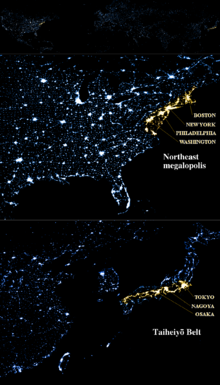Megalopolis (urban landscape)
A megalopolis (Greek for large city ) or mega- region is a large urban landscape in which several megacities have largely grown together.
The term was first used by Oswald Spengler in his influential book Der Untergang des Abendlandes , published in 1918 . In the English-speaking world, the term was introduced by the American historian and sociologist Lewis Mumford in his book The Culture of Cities , published in 1938 , where, as with Oswald Spengler, it stands for the first stage after the cultural climax of Western societies , d. H. the formation of a megalopolis is interpreted as a sign of the beginning decline of a society.
The name Megalopolis was used in 1957 by the French geographer Jean Gottmann for the American east coast urban landscape. This area, named after the northernmost ( Boston ) and southernmost ( Washington ) metropolis of the broad group of cities, Boswash , extends from Boston in Massachusetts via New York City , Philadelphia and Baltimore to the capital Washington, DC With around 40 million people, around 13% of the population lives there US population occupies only 3% of the state's land. The area is characterized by an accumulation of large cities , including several megacities, industrial and commercial locations and traffic facilities, as well as by intensive socio-economic interdependencies.
In the USA, the big cities and their suburbs penetrated further and further into the rural surroundings. More and more such urban bands formed along national roads, where individual cities have grown together like corridors, for example between San Francisco and San Diego or between Chicago , Detroit , Cleveland and Pittsburgh . The term megalopolis was transferred to these urban agglomerations. The slang terms such as Boswash , Sansan and Chipitts have become common in the United States for large city bands. Corresponding areas in other countries are now referred to as megalopolis, for example the Taiheiyō Belt , a highly urbanized region between Tokyo and Fukuoka in Japan , or in Central Europe the blue banana , which is the largest megalopolis in the world.
Most of the time, megalopolises arise on major bodies of water, such as river deltas or entire rivers, often on fertile soil, which enabled a high population concentration early on, from which the urban bands could then develop. Furthermore, the development of raw material deposits, the installation of new infrastructures for traffic, transport and information, the fall of customs borders and trade restrictions as well as processes of industrialization and globalization can all promote the emergence of a megalopolis.
List of megalopolises
Asia
- Taiheiyō Belt , Japan ( Chiba - Fukuoka )
- West coast of Taiwan, Republic of China ( Taipei - Kaohsiung )
- Pearl River Delta , China ( Guangzhou and neighboring cities)
Europe
- Blue Banana ( Liverpool - Milan )
- Golden banana (Mediterranean coasts of Spain, France and Italy to the Po Valley )
North America
- Boswash , USA ( Boston - Washington, DC )
- Sansan , USA ( San Diego - San Francisco )
- Chipitts , USA ( Chicago - Pittsburgh )
Developing megalopolises
Africa
- Egyptian Nile and Eastern Mediterranean Coast ( Aswan Dam to Adana in Turkey)
- South coast of West Africa ( Abidjan - Lagos )
Asia
South America
- Sao Paulo - Rio de Janeiro , Brazil

